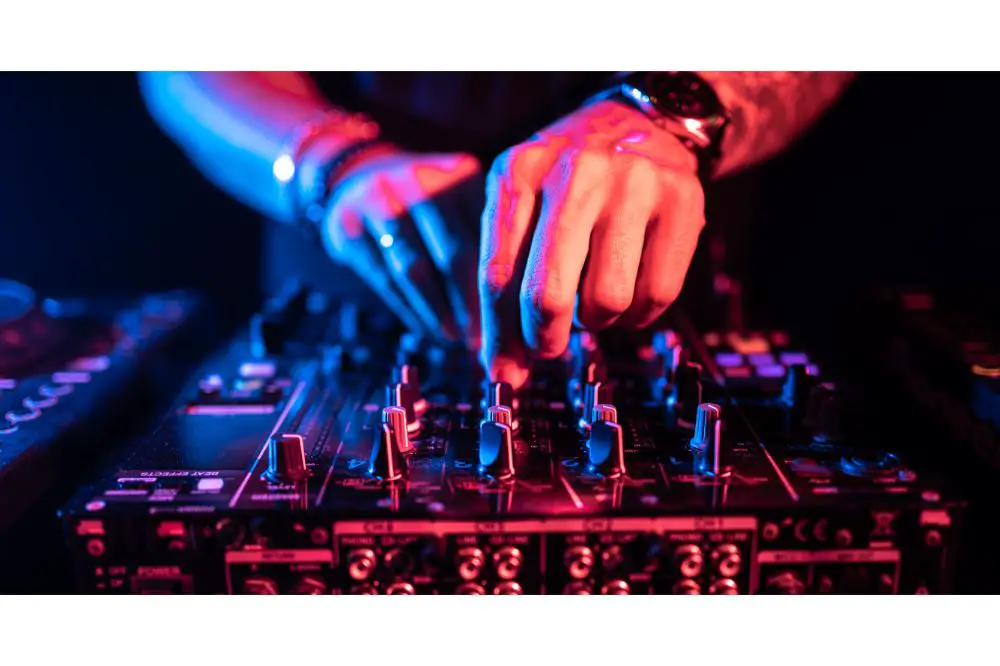If it is time to upgrade your current setup, you are probably looking to increase the number of available channels on your next controller. But do you really need more channels, or will two channels always be enough to up your game as a DJ?
This article looks closely at the differences between a 2-channel mixer and a 4-channel mixer and what to expect from each. We will also take a look at whether you really need those additional inputs to become better as a DJ or not.
Read on and investigate the benefits and the not-so-good of making do with a two-channel mixer or a four-channel mixer.
What is the Difference?
To clarify for those new to DJing, let’s look at the difference between these two types of mixers. A 2-channel mixer gives you control over the two jog wheels that comes standard with your DJ controller.
On the other hand, with a 4-channel mixer, you have two jog wheels and two other input options at your disposal. These extra channels may include anything from two turn tables, one turntable, or a CD input to enhance your options.
Another difference is that a mixer with two channels is more affordable than one with more input options. But let’s go in-depth into the differences between a two-channel and four-channel DJ controller and when you would use them.
Two-Channel Mixer Versus Four-Channel Mixer
While there are a few obvious differences between these two types of controllers, which can be clearly observed standing in front of it, one of these is the number of audio sources you have when it comes to the input from different media types.
What Are these Differences?
Two-Channel Mixer
- With a 2-channel mixer, you will always have just two input options at your disposal, even if you use the auxiliary input. When you use any device through the auxiliary input of your device, it will replace one of your standard input options.
- You have only two channels and their respective control knobs that can be found on top of your 2-channel DJ controller.
- A DJ controller with only two channels is much smaller than those with more input channels.
- You have much fewer physical input options that can be found at the back or on the sides of the mixer.
Four-Channel Mixer
- With this type of DJ controller, you have 4 physical channels at your disposal that can be used for more variety.
- On top of this type of mixer, you have controls for up to four channels visible on top of the device.
- A 4-channel DJ mixer is physically much larger and heavier and takes up more space than a 2-channel mixer.
- More input options for different devices can be seen on the side or at the back of the controller.

Benefits and Disadvantages of the Different DJ mixers
Let’s look at the benefits of these two types of DJ controllers: the expert and the beginner-level DJ. You will find that many of the benefits of these controllers make them more useful for certain DJ applications than others.
Benefits of a 2-Channel DJ Mixer
- One of the first benefits is the size which makes it easier for those with little space to work with. It is also lightweight and can easily be transported in a backpack, making it much better for a traveling DJ.
- With this configuration of DJ controllers, you have much fewer controls to worry about, which means fewer things that can go wrong.
- Another benefit is that it is easier to work with and has fewer controls, so you can focus on your DJ skills. This means you have much less ground to cover when you move your hands around between the different control knobs for different features.
- A 2-channel mixer is the best option if you are more into corporate or fitness events like yoga or doing more club work. This is also why you will find this type of controller is the primary choice among performance DJs and turntablists.
Disadvantages
- Unfortunately, you have only one microphone input option at your disposal with this type of DJ controller.
- Even though you can add more devices through the auxiliary input, you will never have more than two options available simultaneously. As mentioned, when you use your auxiliary input option, it will replace one of your primary inputs, which is a drawback.
- If you are working with a larger mixer setup and need more flexibility, this one is not the right option for you.
Benefits of a 4-Channel DJ Mixer
- You have more channels to work with, which will give you some flexibility and help to improve your DJ creativity. It is also great that every channel comes with its respective controls to allow better control over the overall output.
- Regarding the Mic input, the 4-channel mixer gives you some variety with up to two input options. With an additional microphone input at your disposal, you can have better versatility and output flexibility, which is great for various applications.
- With more audio input sources available, you have a larger choice of devices to use with your mixer channels to increase creativity.
- You also have more audio input ports at your disposal with this larger configuration of DJ controller for a better range of choices.
- You can be far more creative with your music by creating an Automix playlist in Virtual DJ and routing it through one of your channels.
- With the extra channels on this controller, you can easily cue your songs and use pre-fade levels before going live with your music.
- This is the best type of DJ controller for weddings and parties, with its wide range of input and output options for flexibility.
- With the auxiliary input ports, you have more input choices, so you can add extra decks if needed.
- House artists can do easy transitions with more channels at their disposal.
- You have increased variety and can be much more creative with them.
Disadvantages
- Using this type of mixer unit might be a bit more challenging, especially for those new to DJing.
- With more control knobs and lots of ground to cover while working, it will be easier to bump the controls accidentally. So you need to be more careful while working, which involves more things to worry about than just your DJing skills.
- This type of DJ controller is larger and heavier, so it will take up a lot of space and be difficult to travel with.
- These DJ controllers are more expensive, which might be a problem for beginners.
Summary
Regardless of the disadvantages, you have with any of these controllers, they each have their good points for use in different situations. Now that you know the differences, you can easily decide which one will be the perfect choice for your preferences.

